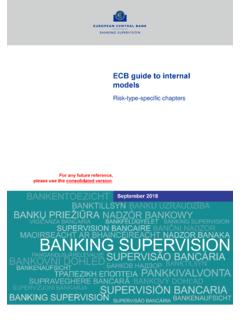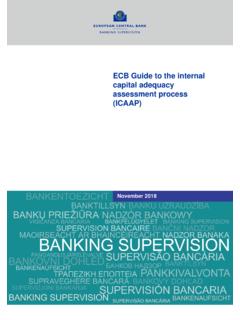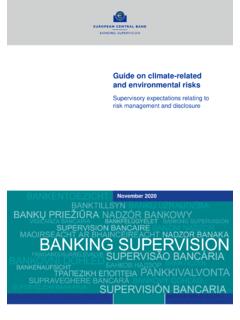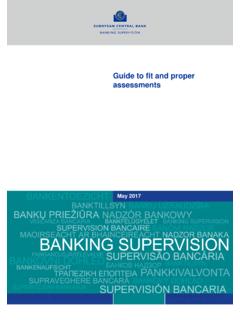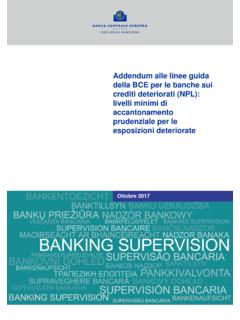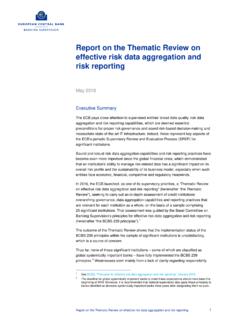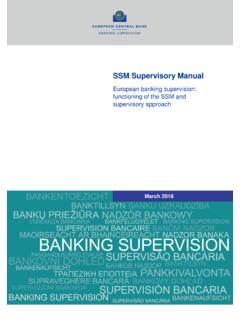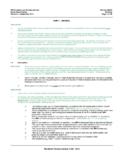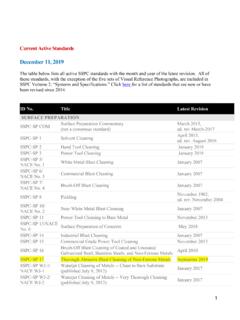Transcription of ECB guide to internal models - ECB Banking Supervision
1 ECB guide to internal models October 2019 ECB guide to internal models Contents 1 Document releases Release Date of issue Release number Sections/Chapters modified Rationale underlying the release guide for the Targeted Review of internal models (TRIM) First version 17/02/2017 - Public Consultation ECB guide to internal models general topics chapter 28/03/2018 General topics Incorporation of institutions feedback on version , outcomes of the supervisory review on general topics, and related horizontal analyses Public Consultation ECB guide to internal models risk-type-specific chapters 07/09/2018 Credit risk, market risk and counterparty credit risk Incorporation of institutions feedback on version and experience gained with TRIM investigations.
2 Addition of dedicated principles for low-default portfolios Revised ECB guide to internal models general topics chapter 15/11/2018 General topics Inclusion of industry s feedback received during the public consultation Revised ECB guide to internal models risk-type-specific chapters 08/07/ 2019 Credit risk, market risk and counterparty credit risk Inclusion of industry s feedback received during the public consultation Consolidated version 01/10/ 2019 Consolidated document Compilation of the general topics and risk-type-specific chapters in one consolidated document ECB guide to internal models Contents 2 Contents Foreword 4 General topics 6 1 Overarching principles for internal models 6 2 Roll-out and permanent partial use 13 3 internal governance 17 4 internal validation 23 5 internal audit 32 6 model use 35 7 Management of changes to the IRB approach 43 8 Third-party involvement 49 Credit risk 56 1 Scope of the credit risk chapter 56 2 Data maintenance for the IRB approach 57 3 Use of data 65 4 Probability of default 73 5 Loss
3 Given default 88 6 Conversion factors 104 7 model -related MoC 112 8 Review of estimates 113 9 Calculation of maturity for non-retail exposures 116 Market risk 117 1 Scope of the market risk chapter 117 2 Scope of the internal model approach 118 3 Regulatory back-testing of VaR models 133 4 Aspects of internal validation of market risk models 144 5 Methodology for VaR and stressed VaR 150 ECB guide to internal models Contents 3 6 Methodology for IRC models focusing on default risk 162 7 Risks not in the model engines 174 Counterparty credit risk 186 1 Scope of the counterparty credit risk chapter 186 2 Trade coverage 187 3 Margin period of risk and cash flows 192 4 Collateral modelling 196 5 Modelling of initial margin 201 6 Maturity 202 7 Granularity, number of time steps and scenarios 205 8 Calibration frequency and stress calibration 207 9 Validation 208 10 Effective expected positive exposure 215 11 Alpha parameter 216 Annex 218 Acronyms 224 Glossary 225 ECB guide to internal models Foreword 4 Foreword 1.
4 Articles 143, 283 and 363 of Regulation (EU) No 575/2013 (CRR)1 require the European Central Bank (ECB) to grant permission to use internal models for credit risk, counterparty credit risk and market risk where the requirements set out in the corresponding chapters of the CRR are met by the institutions concerned. Based on the current applicable European Union (EU) and national law, the ECB guide to internal models provides transparency on how the ECB understands those rules and how it intends to apply them when assessing whether institutions meet these requirements. 2. The guide is also intended as a document for the internal use of the different supervisory teams, with the aim of ensuring a common and consistent approach to matters related to internal models .
5 When applying the relevant regulatory framework in specific cases, the ECB will take into due consideration the particular circumstances of the institution concerned. 3. This guide should not be construed as going beyond the current existing applicable EU and national law and therefore is not intended to replace, overrule or affect applicable EU and national law. In accordance with the requirements set out in the CRR, the European Banking Authority (EBA) has drafted regulatory technical standards (RTS). These include the Final Draft RTS on assessment methodology for the internal Ratings-based (IRB) Approach, the Final Draft RTS on the specification of the nature, severity and duration of an economic downturn and the Final Draft RTS on the specification of the assessment methodology for competent authorities regarding compliance of an institution with the requirement to use internal models for market risk and assessment of significant These specify how competent authorities should assess compliance with the regulatory framework 1 Regulation (EU)
6 No 575/2013 of the European Parliament and of the Council of 26 June 2013 on prudential requirements for credit institutions and investment firms and amending Regulation (EU) No 648/2012 (OJ L 176, , p. 1), referred to in this guide as the CRR . For the purposes of this document the reader s attention is also drawn to the corrigendum published on 30 November 2013 (OJ L 321, , p. 6). 2 Final Draft Regulatory Technical Standards on the specification of the assessment methodology for competent authorities regarding compliance of an institution with the requirements to use the IRB Approach in accordance with Articles 144(2), 173(3) and 180(3)(b) of Regulation (EU) No 575/2013 (EBA/RTS/2016/03), referred to in this guide as the Final Draft RTS on assessment methodology for IRB.
7 See also: Final Draft Regulatory Technical Standards on the specification of the nature, severity and duration of an economic downturn in accordance with Articles 181(3)(a) and 182(4)(a) of Regulation (EU) No 575/2013 (EBA/RTS/2018/04), referred to in this guide as the Final Draft RTS on the specification of the nature, severity and duration of an economic downturn . See also: Final Draft Regulatory Technical Standards on the specification of the assessment methodology for competent authorities regarding compliance of an institution with the requirements to use internal models for market risk and assessment of significant share under points (b) and (c) of Article 363(4) of Regulation (EU) No 575/2013 (EBA/RTS/2016/07), referred to in this guide as the Final Draft RTS on assessment methodology for IMA and significant share.
8 Note that there are no RTS on assessment methodology mandated for the assessment of the internal model Method (IMM) for calculating counterparty credit risk (CCR) exposures. ECB guide to internal models Foreword 5 defined in the CRR. The Final Draft RTS have not yet been adopted by the European Commission, but those Final Draft RTS are referred to in the guide as good practice for interpretative purposes. Some parts of this guide may require revision once the European Commission has adopted the RTS by means of a Delegated Regulation. The ECB will amend or delete those parts of the guide when the RTS enter into force. The ECB provides in this guide its understanding of the CRR provisions which apply currently. The legal references in this guide to the CRR provisions (including the number of the Articles) are references to the CRR before the amendments introduced by Regulation (EU) 2019 /8763.
9 The amendments introduced by Regulation (EU) 2019 /876 which have an impact on the guide will only apply from July 2021. 3 Regulation (EU) 2019 /876 of the European Parliament and of the Council of 20 May 2019 amending Regulation (EU) No 575/2013 as regards the leverage ratio, the net stable funding ratio, requirements for own funds and eligible liabilities, counterparty credit risk, market risk, exposures to central counterparties, exposures to collective investment undertakings, large exposures, reporting and disclosure requirements, and Regulation (EU) No 648/2012 (OJ L 150, , p. 1). ECB guide to internal models General topics 6 General topics 1 Overarching principles for internal models Relevant regulatory references Date of issue Article Paragraph/Point Legal background CRD I V,1 as implemented in the relevant national law 26/06/2013 3, 76, 85 Paragraph 1, sub-paragraphs 7, 9 and 11 CRR 26/06/2013 175, 179, 185, 189, 190, 191, 287, 288, 292, 293, 368 Other references Final Draft RTS on assessment methodology for IRB 21/07/2016 3, 9, 10, 12, 13, 14, 16, 17, 30, 32, 33 Final Draft RTS on assessment methodology for IMA and significant share 22/11/2016 7-34 EBA Guidelines on SREP2 19/12/2014 235 EBA Guidelines on internal governance3 21/03/2018 Section 22 Once adopted by the European Commission.
10 The Final Draft RTS on assessment methodology for IRB and the Final Draft RTS on assessment methodology for IMA and significant share will become additional relevant legal references. Currently these RTSs only exist in a final draft version. 1. The principles listed in this section relate to internal models that are subject to supervisory approval for the calculation of own funds requirements for credit, market and counterparty credit risk (Pillar 1 models ), unless stated otherwise. Guidelines at consolidated and subsidiary levels 2. An inconsistent implementation of internal model -related tasks within a Banking group bears the risk of an inappropriate coverage of the risks measured by internal models at group level. Therefore, institutions should either develop binding group-wide ( consolidated) principles and guidelines relating to the life cycle4 of internal models5, or ensure that each relevant entity has 1 Directive 2013/36/EU of the European Parliament and the Council of 26 June 2013 on access to the activity of credit institutions and the prudential Supervision of credit institutions and investment firms, amending Directive 2002/87/EC and repealing Directives 2006/48/EC and 2006/49/EC (OJ L 176, , p.)
